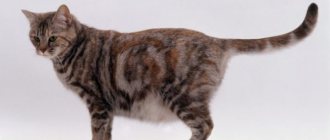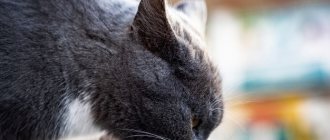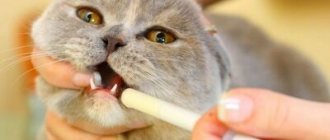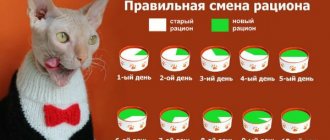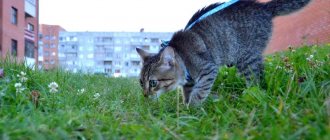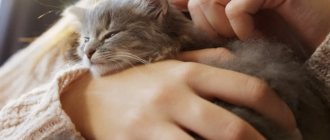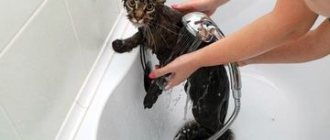This phenomenon is a reflex process of removing the contents of the stomach through the mouth (in rare cases through the nose). At this moment, the abdominal press actively contracts, the animal involuntarily swallows, and profuse salivation appears.
Often, owners do not attach due importance to the problem that has arisen. Perhaps their pet ate something wrong, they think. Yes, they may be right, but it often happens that vomiting in a cat is a symptom of a serious illness. That is why it is very important to understand what exactly caused the vomiting in a domestic cat, and then (if necessary) begin treating your pet.
Common Causes of Vomiting in Cats
In veterinary practice, there are many causes of vomiting in cats; they can be roughly divided into two groups:
- Reflex irritation of the digestive organs - vomiting occurs due to a foreign object entering the stomach and esophagus.
- Intoxication of the body - when a substance enters the bloodstream, it irritates the brain centers of the gag reflex, thereby causing vomiting.
Experts also identify another group, which is somewhat isolated and is associated with disorders of the brain and vestibular apparatus.
So, vomiting in cats can be observed:
- with motion sickness;
- after a concussion;
- as a result of sudden pressure surges.
In these situations, nausea is conditionally a normal reaction of the body.
Causes of vomiting after eating
In this case, the problem cannot be left unattended, because the cause can be either harmless overeating or a serious disruption of the gastrointestinal tract.
- Improper feeding is the most common reason why a cat vomits after eating undigested food. Errors in feeding cause disruption of the digestive system. A pet may vomit from overeating or swallowing too large pieces of food, from intestinal blockage with solid food, etc. Cats have a well-developed gag reflex, so even minor disturbances lead to nausea.
- Accumulation of hair in the intestines. If not properly cared for, this problem often occurs in long-haired and fluffy cats. “Eaten” hairs cause vomiting by mechanical irritation of the intestinal walls. In this case, the removed masses will contain wool. Also, hairballs clog the intestines, complicating its natural cleansing, and causing intoxication of the body. Food entering the esophagus serves only as a kind of trigger.
- Diseases and disorders of the gastrointestinal tract. Accompanied by additional symptoms, regular occurrences of nausea. These may include both mechanical damage to the digestive organs and chronic diseases.
If vomiting is observed constantly, after each meal with undigested food, this leads to serious metabolic disorders. Without timely help, such a problem is fraught with dehydration and exhaustion of the body.
In what cases should you contact a veterinarian?
Any vomiting in a cat with a manifestation of the animal’s external malaise is a reason to contact a veterinarian.
These may include symptoms such as:
- loss of activity;
- refusal of food and water;
- general depressed state;
- increased body temperature;
- impurities in vomit;
- bowel dysfunction - diarrhea, constipation;
- convulsions, unsteady gait, agitation and other disturbances in habitual behavior;
- repeated occurrence of nausea more often than once every three to four days.
You should also immediately contact a veterinarian if your kitten is vomiting. In babies under one year old, even a slight deterioration in their condition leads to serious consequences. Kittens become dehydrated and lose nutrients very quickly.
Additional symptoms
In some cases, vomit may acquire a certain color or contain impurities of bile, blood, and gastric juice. What such signs indicate, we suggest you find out in more detail from the table.
| Color and impurity content | Description of symptoms |
| With white foam | A regular symptom may indicate chronic gastritis, as well as problems with the functioning of the stomach. In isolated cases, an admixture of white foam in the vomit indicates prolonged hunger: the cat has overeaten or swallowed air when swallowing quickly. Air when mixed with gastric juice forms foam |
| With bile | May indicate the development of gallbladder pathologies and liver dysfunction. When bile enters the stomach when eating food, it causes vomiting. In this case, the masses become yellow in color. |
| With gastric juice | Mucus or liquid indicates the presence of gastritis. In rare cases, this is the manifestation of helminthic infestation or viral infection. |
| With blood | Blood is the most dangerous symptom of vomiting. In this case, the animal must be shown to a veterinarian immediately. The presence of bright red blood clots indicates damage to the esophagus and pharynx. Darker impurities mean bleeding in the stomach due to injury to the walls or opening of an ulcer |
| Green vomit | The green tint of the excreted masses most often indicates liver disease and intestinal obstruction. This color is also present after the cat eats grass. |
| Vomiting a pregnant cat | Vomiting in pregnant cats is considered normal. This is due to compression of the digestive organs by the uterine cavity. The food eaten puts strong pressure on the walls of the stomach, causing a conditioned reflex to cleanse it. In addition, pregnant cats may experience hormonal “rebellion.” Then a certain type of food causes nausea |
We suggest you learn some more useful tips from the video from the Vetpuls Veterinary Channel.
Mistakes when organizing feeding
First of all, you should think about how well the feeding is organized. One of the following problems may be occurring.
The cat is vomiting because he has eaten too much
If the owner does not follow the manufacturer's recommendations on feeding standards, the cause of vomiting in the cat may be simple overeating. Practice shows that most of us tend to underestimate the nutritional value of dry foods: they seem light and “frivolous”, which means that you need a lot of them to satiate. Reasoning in this way, owners sometimes exceed the daily norm several times, without thinking about the consequences.
If the pet is not prone to overeating, he simply leaves the excess in the bowl until the next meal. However, not all cats show such moderation: some of them are ready to eat and eat until they feel that their stomach is full to capacity.
When should you not panic?
Vomiting is not always a sign of illness. An acceptable indicator in veterinary medicine is its occurrence once every three to four days without visible additional symptoms.
Experts advise not to panic if the pet remains active, has an appetite, has a healthy coat, and a natural sparkle in the eyes. Periodic “cleansing” vomiting is common in cats. If it occurs immediately after eating, it is necessary to change the diet and monitor the animal’s condition. If it occurs frequently, it is important to consult a veterinarian.
Introduction of food into the diet
The list of cat food is incredibly long. When you come to the store, you can see a huge range of products. All this diversity can be divided into several classes:
- Elite, it is also the most expensive. Suitable for almost all cats, including those who suffer from allergic reactions.
- Premium products are made from natural substances. They are perfectly absorbed by the cat's body.
- The list of cat food contains economy class products. They are made from the cheapest by-products, which are practically indigestible by animals. It is highly not recommended to feed him such food.
Every caring owner should know exactly which food is best for his pet. First, he should introduce it into the diet in a small amount, and after taking it, observe the cat’s condition for several hours. If it has not worsened, then you can continue to put it in the bowl.
Diagnostics
Treatment of the problem begins with correct diagnosis. This is not easy to do at home, and delaying it can lead to deterioration in the animal’s health. It is necessary to conduct an external examination of the pet at a veterinary clinic, as well as a general or biochemical blood test. In some cases, the doctor will need an abdominal ultrasound, endoscopy, or x-ray.
Cat treatment
How to treat the animal will depend on the diagnosis. It is dangerous to self-medicate a cat or cat, and even more so to give any medications on your own. For diseases of the gastrointestinal tract, the veterinarian prescribes a therapeutic diet, astringents and medicinal agents. If vomiting after eating is caused by damage to the internal digestive organs or blockage of the intestines, surgery and enemas will be required. During treatment, it is important to restore the body’s water balance, give light food and provide the animal with rest.
In what cases can you help at home?
You can help an animal yourself in two cases:
- if vomiting with food is caused by improper feeding or poor diet;
- The problem is hair accumulation.
In the first case, it is necessary to establish a feeding regimen - in small portions 4-5 times a day. Preferably soft pureed food. In the second, regularly comb the fur and give the pet prophylactic agents (pastes) for its timely removal from the stomach.
If the cat does not eat and only drinks liquids, you can put it on a starvation diet for a day. But refusal of water should not be allowed. In this case, you need to force it out through a syringe. It is recommended to use purified bottled water without impurities. If the animal begins to vomit immediately after drinking the liquid, it must be taken to the veterinarian immediately.
Giving yourself antiemetic drugs (Cerukal), as well as absorbents (Atoxil), No-shpu and other drugs, is possible only in case of severe poisoning of the animal. In this case, the cat will refuse to eat, and vomiting will occur regardless of the consumption of food and water.
Atoxil (120 rub.)
No-shpa (228 rub.)
Cerucal (136 rub.)
Food for vomiting cats
Very often, after vomiting, the stomach is susceptible to irritants and repeated nausea can occur only due to improper feeding. Immediately after vomiting, you need to maintain the diet for about 6 hours and start feeding your pet soft, light food. It is important to exclude the factor of repeated irritation of the stomach walls. For the first feeding, low-fat baby meat puree is suitable. For the next two days, it is necessary to give food in small portions every 2-3 hours.
When a cat cannot digest dry food, homemade food is recommended:
- boiled rice;
- mashed boiled chicken breast;
- ground meat;
- low-fat cottage cheese.
If vomiting is chronic, a special diet and additional nutrient intake will be required. The complex and diet are prescribed by a veterinarian. A weak decoction of chamomile, given a teaspoon 2-3 times a day, helps control nausea.
Preventive measures
Cat owners note that cats may regurgitate undigested food after consuming dry food. This problem is common when constantly feeding dry, cheap food. Prevention of such phenomena will include a well-designed pet diet, diet, switching to professional wet food or homemade food. High-quality dry food must be given in small portions: when it enters the stomach, the dry granules swell and increase in volume, thereby causing the excess to be rejected.
Another important rule is the prevention of helminthic infestations, as well as intestinal blockages. On a dry diet, the animal must consume enough liquid. Inquisitive pets are limited in their access to small things, threads, pieces of paper, and toys. Be sure to equip the trash can with a lid. In addition to careful grooming, long-haired cats need to be given a special paste to remove hair.
1. Gimpet Cereal hair removal paste. Average price 175 rub.
2. Beafar Multivitamin paste “Duo Active”. Average price 435 rub.
3. Cliny paste. Average price: 200 ml - 450 rubles, 75 ml - 115 rubles.
4. Pasta from Friskies. Average price 400 rub.
Also among the necessary preventive measures, experts name regular examinations in veterinary clinics - once a year for young animals and two or three times over the age of 10 years.
Loading …
Products that should be present in the diet
A caring owner should take a responsible approach to the question of what do cats eat? It is strictly forbidden to feed her with food alone. The diet should also include natural products.
Cats are excellent at digesting lean meats: veal, rabbit or chicken. It is better to abstain from lamb and pork, such products will cause heartburn. It is better to give them boiled.
Any living organism requires natural protein contained in fish. Its excess can also negatively affect the condition of the pet. The optimal dosage is 200-250 grams of this product once a week.
The diet should include vegetables (pumpkin, cauliflower, beets, zucchini and carrots). They contain fiber, vitamins and vegetable fats. They are easily digested in the stomach. Most likely, the pet will refuse to eat them raw. It is recommended to give them in puree form. Greens and dairy products can be consumed in unlimited quantities.
